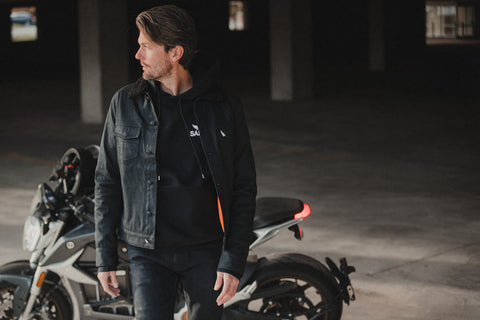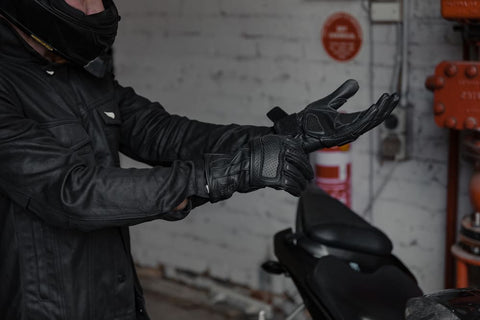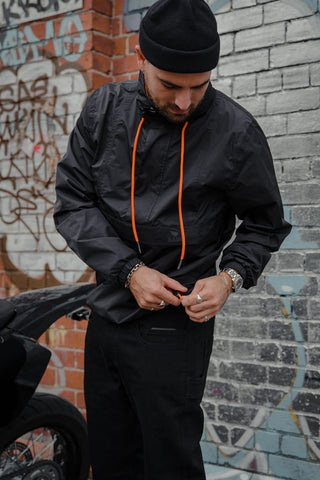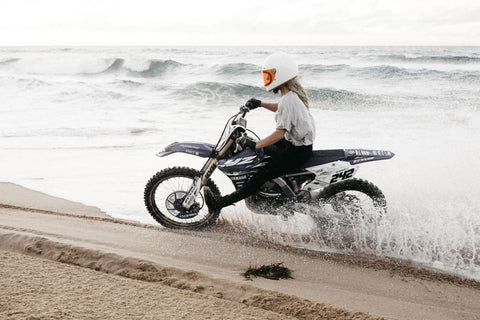When the road gets wet that doesn't mean you have to leave your bike in the garage. Hell, some riders even enjoy riding in the rain. What it does mean is making some adjustments to your riding style, and we've got the rundown for exactly how to handle wet weather riding.
You probably know the basics; drive slower, use your headlights, etc. We'll go beyond the basics so you can stay on top of your game no matter how wet things get. Rain riding can be challenging, especially for new riders, but with a bit of preparation and experience anyone can master it. You might even come to enjoy it.
ESSENTIAL TIPS FOR RIDING A MOTORCYCLE IN THE RAIN

Riding in the wet doesn't have to be a chore. Yes, it's not ideal, but following these tips will keep you as safe and comfortable as possible. Don't let the rain dictate when you can and can't ride.
GET SOME PROPER WATERPROOF GEAR
Nothing sucks like getting your clothes soaked while riding. You're left feeling cold, wet, and miserable. Thankfully you can get yourself some proper rain gear that's specifically made for motorcycles.
Some people go all out and buy a full rain suit, but the downside is they're not exactly stylish. Gear like our armored puffer jacket is a great alternative that mixes style with waterproofing. Another option is a thin polyester anorak that goes straight over any top if you're looking for the cheapest option.
Don't forget about those fingers either! Put on a good pair of riding gloves, because working the controls can get very tricky with frozen fingers.
INSPECT YOUR RIDE
Before you even leave, make sure your bike is ready to handle wet conditions.
Your tires need to be able to channel water, so they'll need to have tread. Check your tires for even wear and make sure they're suitably inflated. Flat tires are obviously no good, but even overinflated tires can make rain riding more challenging.
Your brakes need to be up to the job as well. The brake pads should have plenty of material to stop as needed, so check them for wear and tear.
Lastly, check your oil and brake fluid. There should be no leaks whatsoever, especially from your oil or brake fluid. Leakage can produce some seriously dangerous results in rainy weather.
MAKE YOURSELF VISIBLE
Most drivers don't look out for motorcyclists even in the best of conditions, so make yourself as visible as possible in the wet. Wear some high visibility gear if you have any or at the very least some reflective tape.
Make use of your high beams and hazard lights if the situation calls for it. When the rain comes down hard you won't regret it.
DO SOME PREPARATION
If the rain starts absolutely bucketing down, you should probably stop and wait it out. Have a plan for where you might stop and rest if the riding conditions become unmanageable.
Fogging can become a problem in certain situations. Consider wiping your helmet visor, goggles, and windshield with an anti-fogging treatment before you ride. If your helmet starts fogging up during a ride you can also just keep it open.
BE SMOOTH ON THE BRAKE & THROTTLE
Your bike won't respond the same way on a wet road. While your riding style might be hard and heavy, you'll need to ease off in the rain. Rain impairs traction, so keep it smooth and controlled with the brakes and throttle. You never know if your rear tire is sitting on an extra slick surface, so accelerate nice and easy.
As a guide, drop your speed by about 10-25% for the first 20 minutes of riding. Once you've adjusted to the conditions, keep it to about 90% of your normal speed.

INCREASE YOUR FOLLOWING DISTANCE
Keep a bit of extra distance between yourself and other drivers. No shit, right? This not only buys you some extra reaction time but avoids the dreaded splashback from the car in front of you.
CHANGE YOUR MINDSET
We love going all out on the bike, but that's just not going to happen in the rain. So be realistic in your approach and focus on avoiding obstacles or making jumpy movements.
You don't have to drive like a grandma to safely ride. Just don't accelerate too hard or make any aggressive moves. Play it smart now so you can tear it up later.
BE AWARE OF WET RIDING CONDITIONS & EXTRA SLIPPERY SPOTS
Keep on your toes anytime you ride in the wet. Oils and slippery surfaces can be easy to miss, so don't get overconfident or you might end up paying for it.
Be aware that the first hour after a heavy rainstorm is the most dangerous time to ride. Rain unveils oils that create slippery, wet surfaces which can reduce the traction on your tires. You might want to consider waiting it out so the rain can clear out the road.
Heavy water on the road can cause your bike to hydroplane, no matter how good your tires are. Hydroplaning is when a layer of water prevents direct contact between your tires and the road. To reduce the chances of hydroplaning, try to avoid riding on painted lines, manhole covers, tar snakes, puddles, and metal crossings.
DECREASED VISIBILITY
Riding in the rain creates certain hazards, but sometimes the biggest danger is what you can't see. Keep your eyes peeled and maintain distance so you're always prepared for the unexpected.
LOOK FOR A DRY LINE
This one is fairly obvious but a lot of riders still miss it. While riding on a wet road, look for a dry section that you can drive on. It won't always be there, but when the option presents itself it would be foolish not to take it.
TAKEAWAYS

There's no need to panic if storm clouds are threatening to stuff up your riding plans. All you need to do is plan ahead and adjust your riding style accordingly. Ride smart so you can ride safely. Unless it's absolutely bucketing down, you should be all set to go.
FAQs
HOW DO YOU RIDE A MOTORCYCLE WHEN IT'S RAINING?
So how exactly do you ride a motorcycle when it's raining? The key is to take things easy. Be smooth with your throttle adjustments and braking, and keep your eyes peeled for unexpected obstacles.
Make sure to keep your distance from other drivers and avoid any aggressive driving. The name of the game is control and safety.
IS IT SAFE TO RIDE A MOTORCYCLE WHEN THE ROAD IS WET?
Is it actually safe to ride a motorcycle when the road is wet? While a wet road can make for challenging conditions, with the right precautions you can still drive safely.
Wet roads are slippery, so reduce your speed for safety and give yourself plenty of time to react to unexpected hazards. Avoid sudden acceleration and braking, because your tires can lose traction and skid.
HOW DO YOU RIDE A MOTORCYCLE IN THE RAIN?
How exactly do you ride a motorcycle in the rain? The first step is to wear the right gear. Throwing on a waterproof riding jacket will keep you from getting soaked, while a good pair of riding gloves will keep your fingers from getting frozen.
Keep yourself visible with reflective gear or some reflective tape. Riding in the wet means constantly staying alert and avoiding any cowboy driving.
WHAT TO DO IF IT RAINS WHILE ON A MOTORCYCLE?

Planning for a wet ride is one thing, but what do you do if it rains unexpectantly while already on a motorcycle? The first thing you should consider when it rains while on a motorcycle is pulling over and waiting for the rain to stop or at least let you down.
If that isn't an option then no sweat. Just take it easy and make sure your headlights are on. Reduce your speed by about 15% and take it easy for the rest of the ride. Keep your distance from other vehicles and avoid any sudden, aggressive moves. Don't be afraid to use your high beams or hazard lights either.
IS IT SAFE TO RIDE A MOTORCYCLE IN THE RAIN?
Is it actually safe to ride a motorcycle in the rain? The only time you should pull over and avoid riding is during a seriously heavy downpour or when lightning strikes. Otherwise, taking the proper precautions should keep you safe on the road.
While rain can add challenges to riding, following the tips outlined here should keep you safe during a wet ride. Just use your head and apply common sense whenever riding in the rain.
HOW DO YOU BRAKE ON A MOTORCYCLE IN THE RAIN?
How differently should you brake on a motorcycle in the rain? Because of the loss of traction, you should aim to brake carefully or risk losing control. Brake smoothly, gently, and early to avoid skidding.
Use both the front and rear brakes when stopping. This distributes the braking force more evenly and reduces the risk of skidding.
DOES RIDING IN THE RAIN DAMAGE YOUR MOTORCYCLE?
Riding in the rain doesn't necessarily damage your motorcycle, but it can lead to long-term wear and tear. Obviously, if any water gets into the electrical components it can also lead to problems.
It's a good idea to inspect your bike after a few wet rides, or if you rode through a particularly heavy downpour. Look over the brakes, chain and anywhere else you see fit for signs of rust or corrosion.
HOW LONG AFTER THE RAIN CAN I RIDE MY MOTORCYCLE?
Exactly how long after the rain you can ride your motorcycle depends on the severity of rainfall. You'd be fine hopping on the bike immediately after a light shower. After a heavy downpour, waiting at least 30 minutes for the road to dry and for water to dissipate is ideal.
Ultimately you'll need to use your best judgment. If for whatever reason you need to ride, just practice common sense and seriously consider waiting if the conditions are unmanageable.
HOW DO YOU RIDE A MOTORCYCLE IN HEAVY RAIN?
How you ride a motorcycle in heavy rain involves a few no-brainers, like driving cautiously, keeping your distance from other drivers, and avoiding any aggressive moves.
On motorcycles, however, we don't have the luxury of roofs over our heads, so rain gear is crucial to avoid getting soaked. Visibility is also a must. Wear some high-vis gear (or at least some reflective tapes), keep your headlights on, and don't be afraid to use your high beams.
Keep in mind that motorcyclists are practically invisible to cars when it starts raining, so keep on your toes and give yourself plenty of leeways to deal with the unexpected.


CAN YOU RIDE MOTORCYCLES IN THE RAIN? SOME ESSENTIAL TIPS + INFO
When the road gets wet that doesn't mean you have to leave your bike in the garage. Hell, some riders even enjoy riding in the rain. What it does mean is making some adjustments to your riding style, and we've got the rundown for exactly how to handle wet weather riding.
You probably know the basics; drive slower, use your headlights, etc. We'll go beyond the basics so you can stay on top of your game no matter how wet things get. Rain riding can be challenging, especially for new riders, but with a bit of preparation and experience anyone can master it. You might even come to enjoy it.
ESSENTIAL TIPS FOR RIDING A MOTORCYCLE IN THE RAIN
Riding in the wet doesn't have to be a chore. Yes, it's not ideal, but following these tips will keep you as safe and comfortable as possible. Don't let the rain dictate when you can and can't ride.
GET SOME PROPER WATERPROOF GEAR
Nothing sucks like getting your clothes soaked while riding. You're left feeling cold, wet, and miserable. Thankfully you can get yourself some proper rain gear that's specifically made for motorcycles.
Some people go all out and buy a full rain suit, but the downside is they're not exactly stylish. Gear like our armored puffer jacket is a great alternative that mixes style with waterproofing. Another option is a thin polyester anorak that goes straight over any top if you're looking for the cheapest option.
Don't forget about those fingers either! Put on a good pair of riding gloves, because working the controls can get very tricky with frozen fingers.
INSPECT YOUR RIDE
Before you even leave, make sure your bike is ready to handle wet conditions.
Your tires need to be able to channel water, so they'll need to have tread. Check your tires for even wear and make sure they're suitably inflated. Flat tires are obviously no good, but even overinflated tires can make rain riding more challenging.
Your brakes need to be up to the job as well. The brake pads should have plenty of material to stop as needed, so check them for wear and tear.
Lastly, check your oil and brake fluid. There should be no leaks whatsoever, especially from your oil or brake fluid. Leakage can produce some seriously dangerous results in rainy weather.
MAKE YOURSELF VISIBLE
Most drivers don't look out for motorcyclists even in the best of conditions, so make yourself as visible as possible in the wet. Wear some high visibility gear if you have any or at the very least some reflective tape.
Make use of your high beams and hazard lights if the situation calls for it. When the rain comes down hard you won't regret it.
DO SOME PREPARATION
If the rain starts absolutely bucketing down, you should probably stop and wait it out. Have a plan for where you might stop and rest if the riding conditions become unmanageable.
Fogging can become a problem in certain situations. Consider wiping your helmet visor, goggles, and windshield with an anti-fogging treatment before you ride. If your helmet starts fogging up during a ride you can also just keep it open.
BE SMOOTH ON THE BRAKE & THROTTLE
Your bike won't respond the same way on a wet road. While your riding style might be hard and heavy, you'll need to ease off in the rain. Rain impairs traction, so keep it smooth and controlled with the brakes and throttle. You never know if your rear tire is sitting on an extra slick surface, so accelerate nice and easy.
As a guide, drop your speed by about 10-25% for the first 20 minutes of riding. Once you've adjusted to the conditions, keep it to about 90% of your normal speed.
INCREASE YOUR FOLLOWING DISTANCE
Keep a bit of extra distance between yourself and other drivers. No shit, right? This not only buys you some extra reaction time but avoids the dreaded splashback from the car in front of you.
CHANGE YOUR MINDSET
We love going all out on the bike, but that's just not going to happen in the rain. So be realistic in your approach and focus on avoiding obstacles or making jumpy movements.
You don't have to drive like a grandma to safely ride. Just don't accelerate too hard or make any aggressive moves. Play it smart now so you can tear it up later.
BE AWARE OF WET RIDING CONDITIONS & EXTRA SLIPPERY SPOTS
Keep on your toes anytime you ride in the wet. Oils and slippery surfaces can be easy to miss, so don't get overconfident or you might end up paying for it.
Be aware that the first hour after a heavy rainstorm is the most dangerous time to ride. Rain unveils oils that create slippery, wet surfaces which can reduce the traction on your tires. You might want to consider waiting it out so the rain can clear out the road.
Heavy water on the road can cause your bike to hydroplane, no matter how good your tires are. Hydroplaning is when a layer of water prevents direct contact between your tires and the road. To reduce the chances of hydroplaning, try to avoid riding on painted lines, manhole covers, tar snakes, puddles, and metal crossings.
DECREASED VISIBILITY
Riding in the rain creates certain hazards, but sometimes the biggest danger is what you can't see. Keep your eyes peeled and maintain distance so you're always prepared for the unexpected.
LOOK FOR A DRY LINE
This one is fairly obvious but a lot of riders still miss it. While riding on a wet road, look for a dry section that you can drive on. It won't always be there, but when the option presents itself it would be foolish not to take it.
TAKEAWAYS
There's no need to panic if storm clouds are threatening to stuff up your riding plans. All you need to do is plan ahead and adjust your riding style accordingly. Ride smart so you can ride safely. Unless it's absolutely bucketing down, you should be all set to go.
FAQs
HOW DO YOU RIDE A MOTORCYCLE WHEN IT'S RAINING?
So how exactly do you ride a motorcycle when it's raining? The key is to take things easy. Be smooth with your throttle adjustments and braking, and keep your eyes peeled for unexpected obstacles.
Make sure to keep your distance from other drivers and avoid any aggressive driving. The name of the game is control and safety.
IS IT SAFE TO RIDE A MOTORCYCLE WHEN THE ROAD IS WET?
Is it actually safe to ride a motorcycle when the road is wet? While a wet road can make for challenging conditions, with the right precautions you can still drive safely.
Wet roads are slippery, so reduce your speed for safety and give yourself plenty of time to react to unexpected hazards. Avoid sudden acceleration and braking, because your tires can lose traction and skid.
HOW DO YOU RIDE A MOTORCYCLE IN THE RAIN?
How exactly do you ride a motorcycle in the rain? The first step is to wear the right gear. Throwing on a waterproof riding jacket will keep you from getting soaked, while a good pair of riding gloves will keep your fingers from getting frozen.
Keep yourself visible with reflective gear or some reflective tape. Riding in the wet means constantly staying alert and avoiding any cowboy driving.
WHAT TO DO IF IT RAINS WHILE ON A MOTORCYCLE?
Planning for a wet ride is one thing, but what do you do if it rains unexpectantly while already on a motorcycle? The first thing you should consider when it rains while on a motorcycle is pulling over and waiting for the rain to stop or at least let you down.
If that isn't an option then no sweat. Just take it easy and make sure your headlights are on. Reduce your speed by about 15% and take it easy for the rest of the ride. Keep your distance from other vehicles and avoid any sudden, aggressive moves. Don't be afraid to use your high beams or hazard lights either.
IS IT SAFE TO RIDE A MOTORCYCLE IN THE RAIN?
Is it actually safe to ride a motorcycle in the rain? The only time you should pull over and avoid riding is during a seriously heavy downpour or when lightning strikes. Otherwise, taking the proper precautions should keep you safe on the road.
While rain can add challenges to riding, following the tips outlined here should keep you safe during a wet ride. Just use your head and apply common sense whenever riding in the rain.
HOW DO YOU BRAKE ON A MOTORCYCLE IN THE RAIN?
How differently should you brake on a motorcycle in the rain? Because of the loss of traction, you should aim to brake carefully or risk losing control. Brake smoothly, gently, and early to avoid skidding.
Use both the front and rear brakes when stopping. This distributes the braking force more evenly and reduces the risk of skidding.
DOES RIDING IN THE RAIN DAMAGE YOUR MOTORCYCLE?
Riding in the rain doesn't necessarily damage your motorcycle, but it can lead to long-term wear and tear. Obviously, if any water gets into the electrical components it can also lead to problems.
It's a good idea to inspect your bike after a few wet rides, or if you rode through a particularly heavy downpour. Look over the brakes, chain and anywhere else you see fit for signs of rust or corrosion.
HOW LONG AFTER THE RAIN CAN I RIDE MY MOTORCYCLE?
Exactly how long after the rain you can ride your motorcycle depends on the severity of rainfall. You'd be fine hopping on the bike immediately after a light shower. After a heavy downpour, waiting at least 30 minutes for the road to dry and for water to dissipate is ideal.
Ultimately you'll need to use your best judgment. If for whatever reason you need to ride, just practice common sense and seriously consider waiting if the conditions are unmanageable.
HOW DO YOU RIDE A MOTORCYCLE IN HEAVY RAIN?
How you ride a motorcycle in heavy rain involves a few no-brainers, like driving cautiously, keeping your distance from other drivers, and avoiding any aggressive moves.
On motorcycles, however, we don't have the luxury of roofs over our heads, so rain gear is crucial to avoid getting soaked. Visibility is also a must. Wear some high-vis gear (or at least some reflective tapes), keep your headlights on, and don't be afraid to use your high beams.
Keep in mind that motorcyclists are practically invisible to cars when it starts raining, so keep on your toes and give yourself plenty of leeways to deal with the unexpected.